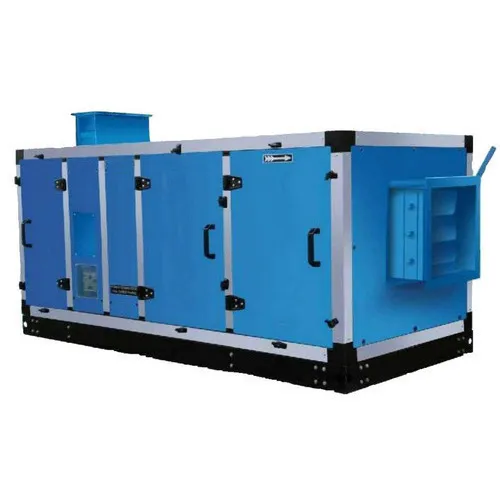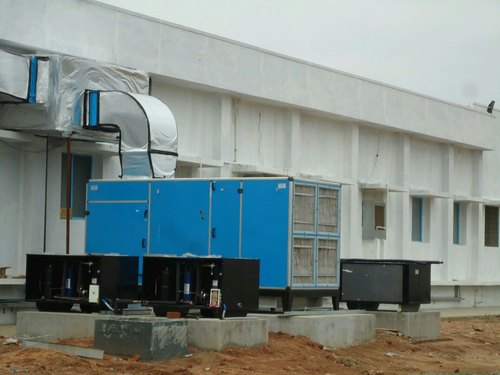Air Handling Unit (AHU)

What is an air handling unit (AHU)?
An air handling unit, commonly called an AHU, is the composition of elements mounted in large, accessible box-shaped units called modules, which house the appropriate ventilation requirements for purifying, air-conditioning or renewing the indoor air in a building or premises.
They are usually installed on the roof of buildings and, through ducts, the air is circulated to reach each of the rooms in the building in question.
The air handling unit (AHU) is the heart of central air conditioning. It collects outside air and room air, removes dust and other particles from the collected air, adjusts the temperature and humidity and then supplies comfortable and refreshing air-conditioned air into the rooms through ducts.
Product Description:
An Air Handling Unit (AHU) is used to re-condition and circulate air as part of a heating, ventilating, and air-conditioning system. The basic function of the AHU is to take in outside air, re-condition it, and supply it as fresh air to a building.
AHU’s supply fresh air to the room. The units take air from the outside, filter it and recondition it (cooled by a cooling coil or heated by a heating coil). Where hygienic needs for air quality are lower, the air from the rooms can be re-circulated for energy-saving purposes.
Features:
- Easy installation
- Low maintenance
- Longer service life
We feel proud to introduce ourselves as one of the reckoned manufacturer, trader and supplier of a top grade assortment of Air Handling Unit. Our air handling unit is demanded in labs, tile industry, jute industry, hospitals and metal parts industry. This air handling unit is designed in fulfillment with international quality standards utilizing top notch material. We are providing our air handling unit on different specifications so as to fulfill the demand of customers.

For Product Enquiry Write to Us
An air handling unit (AHU) is a critical piece of equipment in any successful indoor cultivation operation. A properly designed and installed AHU provides clean, fresh air to the room where the plants are grown, helping them to thrive and grow at their optimal rate.
A properly designed and maintained air-conditioning system is necessary for proper ventilation and to maintain a healthy environment inside your grow room. While these systems are commonplace in residential settings, they have only recently become popular in commercial marijuana cultivation facilities. A poorly engineered or improperly sized or installed HVAC system can cause significant problems for your facility’s success. If you’re planning on starting a cannabis cultivation business, understanding the basics of how an air conditioning system works in relation to cannabis cultivation will help ensure a smooth start.
The three primary components of an air conditioning system are the blower, filter, and ductwork. Your AHU consists of all three elements. These three basic pieces are responsible for filtering out contaminants from the air being delivered to your plants and maintaining a desired temperature throughout your entire grow space.
Blowers
The blower is a powerful fan motor that forces air through the filters and ductwork of the unit and brings the outside air back into the grow room. Blowers are typically powered by either an electric motor or a gas engine. Electric motors tend to run cooler than gas engines, resulting in fewer potential issues with overheating. However, electric motors require additional maintenance, and gas engines are much easier to operate. Both types of blowers are generally well suited to the task of bringing fresh air to your grow room.
Filters
You’ll find two types of filters in most air handling units. One type is called an HEPA filter; the second is known as a true HEPA filter. An HEPA filter is short for high efficiency particulate arrestance, while a true HEPA filter is marketed as just HEPA. Both types of filters capture microscopic particles and harmful gases emitted by the human body. Most traditional blowers use HEPA filters, although some manufacturers offer the option of using a true HEPA filter instead. True HEPA filters are more expensive than their HEPA counterparts, but they last longer and perform consistently better.
Ductwork
Finally, the ductwork is responsible for moving air throughout your grow room. You’ll find several different types of ductwork depending upon what type of blower you choose. Most commonly, you’ll find that your unit uses a single channel blower, which simply means that it blows through a single passageway in your unit’s ductwork. Other options include multi-channel blowers, which allow the blower to move air through more than one path, and dual-pass blowers, which provide both a cooling and heating effect on the air passing through its channels. In general, the more channels you add to your unit’s ductwork, the more power you’ll need to operate it. Multi-channel blowers and dual-pass blower systems are best suited to larger grow rooms.
To make sure you have the best possible results from your air conditioning setup, you should first determine if you want to use a true HEPA filter or not. Many people don’t realize that HEPA filters aren’t perfect, and they can actually trap pollutants that could otherwise harm the plants. Because many of the contaminants that enter a grow room are microscopic, even a good quality filtration system might not be able to completely remove them. A true HEPA filter will create a barrier between the exhaust air and the intake air, preventing particles from entering the room.
However, even a true HEPA filter won’t protect your plants from all forms of airborne contamination. A number of chemical substances are released into the air by humans, including paint, pesticides, and cleaning products. Even if you install a true HEPA filter, you may still find yourself struggling with these kinds of pollutants. To avoid any unwanted chemicals from entering your grow room, you should always check the manufacturer’s guidelines before installing your AHU.
Once you’ve chosen whether you want to use a HEPA filter or not, consider investing in a variable speed fan. Variable speed fans automatically adjust their speeds based on changes in ambient temperatures. As the temperature drops, you’ll notice that the blower runs slower and draws less air, reducing the temperature of the air in your grow room. The opposite happens when the temperature rises; the fan turns faster and pulls more air in, increasing the temperature of the air. By running your fan at lower speeds when the temperature falls, you’ll reduce the amount of time your plants are exposed to potentially damaging conditions.
When choosing your air conditioning unit, keep in mind that bigger isn’t necessarily better. You’ll save money by buying a smaller unit that has less horsepower, so you can fit more units in a given area. Larger models also weigh more and take up more space, making them harder to transport around your entire grow space. Smaller units are ideal for small spaces that benefit from quick and convenient access to filtered air.


